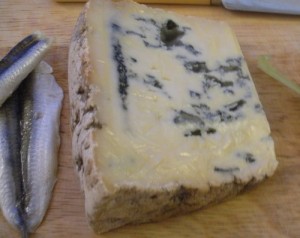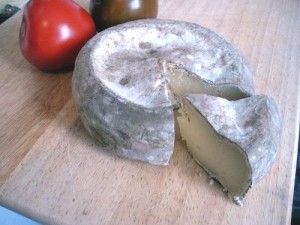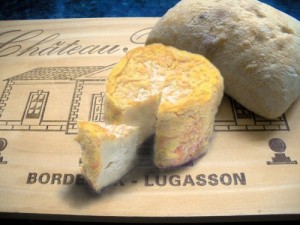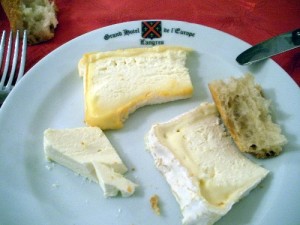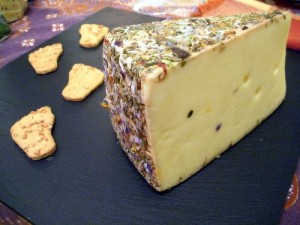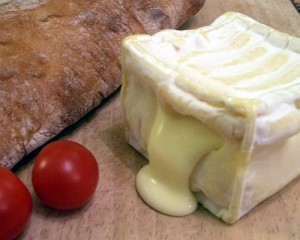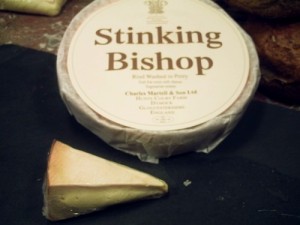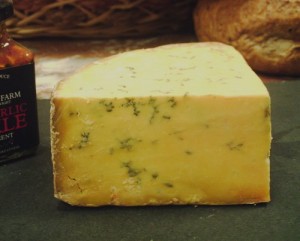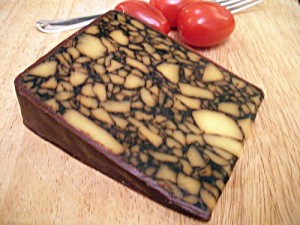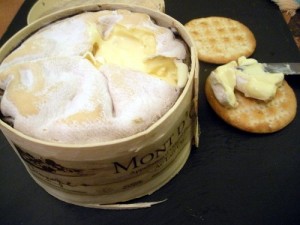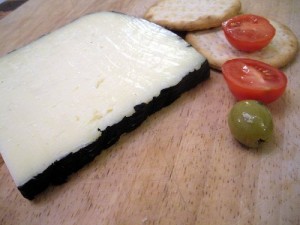Archive for the ‘Cow’s milk’ Category
Binham Blue
August 4th, 2013 Posted 4:20 pm
Soft creamy yellow with starkly contrasting deep green/blue veins, a gnarled rind dusted in white moulds. This looks just like a blue cheese ought to.
The paste is soft and yields under pressure, but not quite enough to spread.
It has a very mild creamy taste, with bitter overtones, but not in the least bit sharp, like so many other blue cheeses. Other than that, there is little to say. It’s OK… a blue cheese for people that don’t like blue cheese.
It looks fantastic, and creates an anticipatory expectation that, sadly, fails to be met.
Purchased from Larners, Holt.
Reviewed by Nick & Olympia 2012




 (2/5)
(2/5)
Posted in 2 Stars - OK, Blue, Cow's milk, English, Semi-soft
Tomme de Vache
July 21st, 2013 Posted 8:29 pm
In a French motorway stop, there was a craft fair and a man selling cheese. Amongst his offerings was this rather gruesome looking object. Gnarled, grey with bits of white, it looks like a lead weight that’s sat at the bottom of the sea for a few years… so we had to buy it ![]()
About 4″ (10 cm) diameter, with a leathery, dirty grey rind, this little cheese looks like it has seen better days. The outside smells strongly of ammonia, like it’s been sat at the bottom of a pigeon coop for a few weeks.
The pate is a dirty yellow colour, greying towards the outside edge. It smells very strongly milky and slightly blue. The texture is soft, rubbery and creamy.
The flavour is, however, not strong. Slightly alpine, milky with bitter overtones. Despite its rough appearance, it is a rather delightful little cheese.
Reviewed by Nick, Olympia & guest reviewer, author John Bartlett




 (3/5)
(3/5)
Posted in 3 Stars - Good, Cow's milk, French, Hard
Langres
July 7th, 2013 Posted 5:22 pm
This rather smelly, but delightful cheese is made in the Champagne region of France in the town of the same name. Bright yellow/orange, sticky, wrinkly and sunken in the middle, Langres looks like a deflated alien brain.
About 3″ in diameter, and washed in Champagne mixed with annatto, to give it the orange rind, Langres is quite a smelly little cheese, slightly sweet, pungent but not stinky.
Then dent in the top is apparently due to the fact that it is only turned twice during maturation. As the whey and wash drains through the cheese, causing the top collapses in. Some aficionados will pour wine, Champagne or spirits into this dent before serving.
In younger cheeses, the paste is quite firm, but it starts to go gooey around the edges as it matures. Ideally, it is about right when this process has reached about half way (about 1cm). The flavour is complex, there’s a fresh sharpness that makes way to a much mellower and satisfying flavour that has a great deal of character. Eaten with a sip of wine, brings out a floral quality.
Purchased from Selfridges, London
Reviewed by Nick & Olympia 2010




 (4/5)
(4/5)
We originally reviewed this cheese in 2010, but on a recent trip to France spent a day in Langres. Of course we had to try this cheese in its home town, although avoiding it would have been difficult. In this town, it seems that everything is either cooked or served with Langres.
Top: Langres – Bottom left: Langres fraiche – Bottom right: Chaource
We discovered that the Langres cheese is also eaten fresh. It is pleasant enough, but tastes very much like any other fresh cheese. So, we’re glad that they drown it in booze and let it fester for a couple of months.
Posted in 4 Stars - Very Good, Cow's milk, French, Semi-soft, Washed
Wildblumenkäse
May 28th, 2013 Posted 12:14 am
| This rather peculiar and delightful offering was brought over, a couple of weeks ago, from Germany by Marjam (aka Maus) a lifelong friend of Olympia’s.It comes from the Allgäu in the Alpine area of southern Germany……and, yes, it is covered with wild flowers!
The pate is a pale yellow, with the odd round bubble hole in it, very similar to many other Alpine cheeses. Of course, what makes this particular cheese rather unique is that they coat it in colourful, dried, wild flowers. Red, orange, mauve, white and green petals and herbs make it look more like pot-puris than a cheese, and it smells like it too. The rind smells of hay, lavender and aromatic pipe tobacco. The pate itself has a very faint alpine cheese smell. The flavour is mild, sweet and milky. The rind is edible, and it’s a good job too, because it turns this otherwise bland and unexciting cheese into something special. The rind tastes much like it smells: lavender; hay; flowers and herbs, with a subtle but definite underlying Alpine flavour. An interesting experience and definitely something to seek out if you find yourself in that part of the world.
[the feet in the picture are German cheese biscuits, called käsefüss (Cheesy Feet) also brough over by Maus |
Reviewed by Nick & Olympia, 2013.




 (3/5)
(3/5)
Posted in 3 Stars - Good, Cow's milk, German, Hard, Unusual cheese
Pavé d’Affinois
April 28th, 2013 Posted 5:54 pm
This delightful little offering was brought to our Sunday night cheesefest by Olympia’s cousin, Annabel on a recent visit.
It came in a little cardboard box, which had managed to adhere itself to the rind. As a result, the rind tore on opening, spilling it’s gooeyness on to the plate. It did, however, make for a good photo opportunity. ![]()
The name caused us a lttle confusion. Pavé is often used to descibe square slabs of French cheese, from French word for cobble or paving stone. However, there is no place called Affinois. We finally came to the conclusion that affinois is a word made up by the manufacturers to reflect its refined (affiner) ultrafiltration process.
It has pale ivory rind dusted with a bloomy white mould which smells mildy of ammonia and cow shed. The paste is gooey, almost liquid with scents of honey.
The texture is extremely decadent and the flavour very mild and a bit non-descript. However, when taken with wine, it releases the wonderful taste of honey.
Not tremendously exciting. It is labeled as “brie like”, and would make a more interesting replacement on the cheese board.
Purchased from Marks & Spencer.
Reviewed by Nick & Olympia (with guest reviewer Annabel).




 (2.5/5)
(2.5/5)
Posted in 2 Stars - OK, Cow's milk, French, Soft
Stinking Bishop
April 22nd, 2013 Posted 12:07 am
Made famous by the Wallace and Gromit film “Curse of the Were-rabbit”, this is one of, sadly, few English washed rind cheeses. The practice of washing cheeses was developed by monks, which, when king Henry VIII wiped out the monasteries, also died out.
Washing cheeses enriches the flavour and has the side effect of making the cheese very smelly. (Epoisses, possibly being the most notable. Washed in brandy and banned on the Paris metro because of the resultant pungent aroma.)
Stinking Bishop cheese is washed in perry (pear cider) made from Stinking Bishop pears, the colloquial name for the Moorcroft variety. This pear was apparently grown by a Mr. Bishop, who, by some accounts, was not a particularly pleasant character.
All this aside, does it actually live up to its name? Well, yes and no. Most washed cheeses are smelly, and this is no exception, but it isn’t as overpowering as the name suggests. Even a ripe Camembert would beat it in it’s nostril assailing quality. That said, you probably wouldn’t want to sit in the car with one of these in the picnic hamper, on a hot summer day without the windows open.
Like most washed cheeses, the rind is sticky, with a pale pink/orange colouration. The texture is gooey, but has a slight “bounce” to it. The flavour is actually quite mild. Smooth and creamy with a slightly bitter after taste. It’s pleasant enough, but nothing special.
The main appeal of this cheese is the kudos of having tried it or serving it up to friends on the cheese board.
Reviewed by Nick & Olympia, 2011.




 (3/5)
(3/5)
Posted in 3 Stars - Good, Cow's milk, English, Soft, Washed
Shropshire Blue
April 2nd, 2013 Posted 4:52 pm
| Despite its name, Shropshire Blue was invented in Inverness, and according to our sources, no Shropshire Blue is actually made in Shropshire. 8OColoured with annatto, this cheese has a wonderful golden orange colour with starkly contrasting blue/green veins.
It is based on the Stilton recipe and, other than its colour, is very similar in appearance and texture. Hard and crumbly with a gnarled greyish rind. The smell is similar too, though there are overtones of caramel. This characteristic also comes through in the flavour, which is again similar, but not as strong and acidic as Stilton. It has a very “blue” flavour, yet it is smooth and creamy with none of that aggressive Stilton “bite”. All in all a very pleasant cheese and well work seeking out. It’s not too difficult to find and can be found in some supermarkets. It keeps well, so the quality seems to be fairly consistent. |
Reviewed by Nick & Olympia 2010




 (4/5)
(4/5)
Posted in 4 Stars - Very Good, Blue, Cow's milk, English, Hard
Irish Porter
March 25th, 2013 Posted 12:01 am
Wow! What visually stunning cheese! With its chocolate coloured wax rind and dark brown and gold terrazzo like appearance, this promises to be an exciting discovery. Made with porter house ale, produced by Guinness, it just tantalises you in anticipation of what lies in store.
However, looks and pedigree sometimes amount to very little, and this is sadly the case here. This is the Celine Dion of the cheese world, beautiful to look at, but no personality.
It has a milky, mild cheddar flavour with a slight hint of bitterness, but where’s the porter house ale?
It would make a fantastic centerpiece for any cheeseboard, and is bound to impress and initiate cheesy conversation, but for the hardend cheese afficionado… forget it.
Purchased from Cheese Please, Lewes.
Reviewed by Nick & Olympia, 2013




 (2/5)
(2/5)
Posted in 2 Stars - OK, Cow's milk, Flavour added, Hard, Irish
Vacherin Mont d’Or
March 17th, 2013 Posted 7:26 pm
| Vacherin Mont d’Or is normally supplied in small, round, open topped, wooden boxes about 6 inches (15cm) diameter and wrapped in cellophane. Though bigger wheels are made, they are not particularly practical, for reasons that will become clear later. The uneven surface is a pale pinky yellow, dusted with white, yielding easily under pressure when ripe.
This cheese is only available between September and March. The story goes, that it is made from milk from the same cows that normally goes into making Gruyère. However, during the winter months, the cows are brought down from their mountain pastures, put into barns for the winter and fed on hay. The result is the thicker creamier milk used to make this cheese. Breaking through the cellophane wrapping, releases a wonderful earthy aroma of pine, farmyard and mushrooms. Under the rind, the cheese itself is very gooey, almost liquid and needs to be spooned out carefully onto the chosen comestible vehicle. The texture is creamy and decadent with a smooth taste, full of subtle aromas of meadows and hay. Around the perimeter, the flavour becomes strong with the turpentine like flavour of pine sap from the spruce bark, that lines the box. This adds a wonderful edge to the character of this cheese. A traditional way of enjoying Vacherin Mont d’Or, is to make a hole in the top and pour in a spoonful of white wine. Then place the whole cheese into the oven for 20 minutes. This makes it even more liquid, into which chunks of bread can be dipped. Thereby turning it into a sort of instant fondue. Vacherin Mont d’Or is quite expensive, costing about £12 for the whole cheese, but is worth it. However, it should be noted that there is another cheese that goes by the name of Vacherin. This is not the same thing at all and is rather disappointing in comparison. |
Purchased from Cheese Please, Lewes.
Reviewed by Nick & Olympia, 2012.




 (4/5)
(4/5)
Posted in 4 Stars - Very Good, Cow's milk, Soft, Swiss
Pyrénée Noir
March 10th, 2013 Posted 8:23 pm
Also know as Tomme des Pyrénées, this is a visually striking cheese, covered in a black plasticky wax. The very pale yellow, almost white, pate is soft, flexible and oily looking.
It has a sweet buttermilk smell, a soft bite with a pleasing texture. The flavour is, as expected, delicate, milky and sweet. Typically cheesy, but not strong.
This is the sort of cheese that would be suitable for children and those who don’t like strong cheeses and would normally choose Edam or Port Salut.
Unexciting for the hardened cheese buff, but pleasant and inoffensive.
Purchased from the cheese stall outside Brighton Station
Reviewed by Nick & Olympia 2012




 (2/5)
(2/5)
Posted in 2 Stars - OK, Cow's milk, French, Hard

